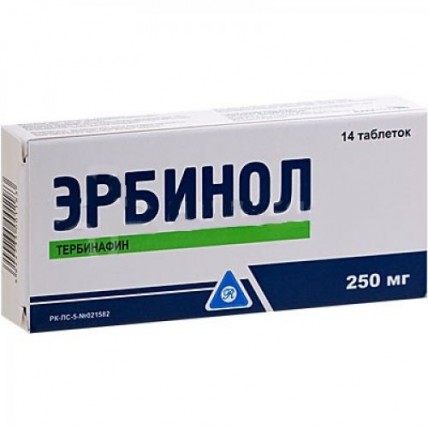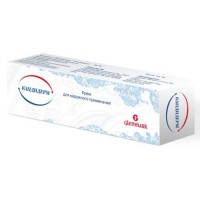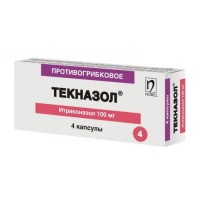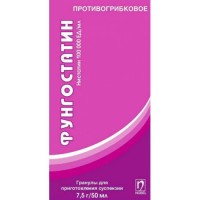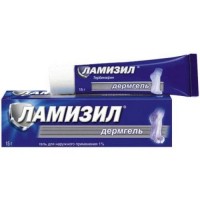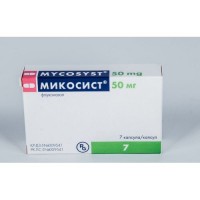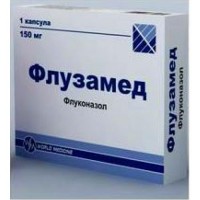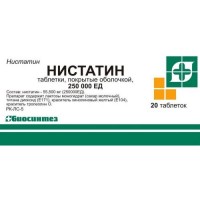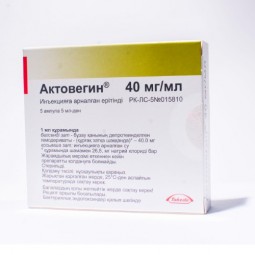Erbinol 250 mg (14 tablets)
- $31.80
Trade name
Erbinol
Mezhdunarodnoye the unlicensed
name Terbinafin Lekarstvennaya a form
of the Tablet of 250 mg
the Description
of the Tablet of round shape, with a flat surface, from white till yellow-white color.
Structure
One tablet contains
active agent - terbinafin 250 mg (in the form of a terbinafin of a hydrochloride of 281.30 mg),
excipients: cellulose microcrystalline (pH 101), starch corn, silicon dioxide colloidal anhydrous, gipromelloza, talc, magnesium stearate.
Pharmacotherapeutic group
Antifungal drugs for treatment of diseases of skin. Antifungal drugs for system use. Terbinafin.
The ATX D01BA02 CODE
the Pharmacological
Pharmacokinetics Later properties of intake terbinafin is well absorbed (& by gt, 70%), the absolute bioavailability of a terbinafin owing to effect of the first passing is about 50%. After single dose of a terbinafin inside in a dose of 250 mg of its Cmax in plasma it is reached in 1.5 h and makes 1.3 mkg/ml. Meal does not influence bioavailability of a terbinafin.
Linking with proteins of blood plasma makes 99%. Within the first several weeks after the beginning of administration of drug inside terbinafin collects in skin and nail plates in the concentration providing fungicide action.
As a result of biotransformation terbinafin it will be transformed to metabolites which have no antifungal activity and are removed mainly with urine.
T½ makes from 11 to 17 h. Any proofs of cumulation of drug in an organism are not available.
The pharmacodynamics
Terbinafin represents allylamine and has a wide range of antifungal action. The mechanism of action is connected with specific oppression of an early stage of biosynthesis of sterols in a cellular membrane of mushrooms. It results in deficiency of ergosterol and to intracellular accumulation of squalene that causes death of cells of a mushroom. Action of a terbinafin is carried out by skvalenepoksidaza inhibition in cellular membranes of mushrooms. This enzyme does not belong to a system P450 cytochrome therefore terbinafin does not influence metabolism of hormones or other medicines.
Terbinafin has effect on dermatophytes, yeast-like and mold mushrooms, some dimorphous mushrooms. In low concentration has fungicide activity concerning dermatophytes (Trychophyton rubrum, Trychophyton mentagrophytes, Trychophyton verrucosum, Trychophyton violaceum, Trychophyton tonsurans, Microsporum canis, Epidermophyton floccosum), mold mushrooms (including Aspergillus, Cladosporium, Scopulariopsis brevicaulis). Action on barmy mushrooms of the sort Candida (in the main Candida albicans) can be fungicidal or fungistatic depending on a species of a mushroom.
The indications
of Fungal skin of infections and nails caused by dermatophytes, such as, of Trichophyton (for example, T.rubrum, T.mentagrophytes, T.verrucosum, T.violaceum), Microsporum canis and Epidermophyton floccosum
- treatment depriving (mycosis of smooth skin of a trunk, an inguinal epidermophitia and a dermatofitiya of feet) when defeat localization, the expressiveness or prevalence of an infection cause expediency of oral therapy
- treatment of onychomycoses.
The route of administration and doses
of the Pill are taken inside with water. It is recommended to take the drug daily in identical time for a hungry stomach or after a meal.
The adult drug is appointed inside on 250 mg of 1 times a day.
The recommended treatment duration at:
- a dermatomycosis of feet (interdigital, bottom or on the moccasins type – 2-6 weeks,
- a trunk dermatomycosis - 4 weeks,
- an inguinal epidermophitia – 4 weeks,
- an onychomycosis - from 6 weeks to 3 months,
the Periods of treatment lasting less than 3 months can last at patients with damage of nails on fingers of hands, nails on toes, except a thumb, or at patients of younger age.
At treatment of damages of nails on toes there are usually enough 3 months, however some the course of treatment lasting 6 months or longer can be required by patients. Patients who will need longer course of treatment, determine by the reduced growth rate of nails in the first weeks of treatment.
Total disappearance of signs and symptoms of an infection can come only in several weeks after identification of lack of activators, by means of laboratory control.
Patients with an abnormal liver function. Terbinafin in tablets is not recommended to apply at patients with a chronic or active disease of a liver.
Patients with a renal failure. Terbinafin's use in tablets for patients with a renal failure is properly not studied and therefore it is not recommended to this group of patients. Children. The data on safety of oral administration of drug of Terbinafin at children received during the research of the post-marketing use of the drug Terbinafin conducted in Great Britain with participation of 314 patients demonstrate that the profile of the undesirable phenomena at children is similar to that at adults.
Proofs of emergence of any new, unusual or more serious reactions, than those which were noted among adult patients, no. For today data on drug use to children are limited therefore its use is not recommended to this age category of patients
Patients, advanced age. There are no bases to believe that patients of advanced age need to change the mode of drug dosing or that they note the side effects differing from those at patients of younger age. In case of use in this age group of drug in tablets it is necessary to take the probability of an abnormal liver function or kidneys into account.
Side effects
For assessment of frequency of emergence of various side reactions the following classification is used: very often (≥1/10), it is frequent (≥1/100, & lt, 1/10), infrequently (≥1/1000, & lt, 1/100), is rare (≥1/10,000, & lt, 1/1000), is very rare (& lt, 1/10,000), frequency is unknown (it is impossible to establish on the basis of the available data).
- Very often
- the loss of appetite
- gastrointestinal symptoms (feeling of overflow of a stomach, dyspepsia, nausea, pain in a stomach, diarrhea)
- not severe forms of reaction of skin (rash, urticaria)
- reactions from a musculoskeletal system (arthralgia, myalgia)
is frequent
- a headache
Infrequently
- disturbance of taste, including loss of taste which is usually restored in several weeks after the termination of administration of drug. It was very seldom reported about long disturbance of taste that sometimes leads to decrease in the consumption of food and considerable loss of body weight.
Seldom
- paresthesia, a hypesthesia, dizziness
- heavy abnormal liver functions, including a liver failure, increase in level of enzymes of a liver, jaundice, a cholestasia and hepatitis. If the abnormal liver function develops, treatment by Terbinafin needs to be stopped. Very seldom messages about a serious liver failure arrived (some cases with a lethal outcome or cases which demanded liver transplantation). In most cases a liver failure at patients noted serious basic general diseases, and relationship of cause and effect with Terbinafin's reception was doubtful.
- the indisposition
is Very rare
- a neutropenia, an agranulocytosis, thrombocytopenia
- anaphylactoid reactions (including a Quincke's edema), a skin and system lupus erythematosus
- vertigo
- serious skin reactions (for example a multiformny erythema, Stephens-Johnson's syndrome, a toxic epidermal necrolysis)
- photosensitivity (for example a photodermatosis, reaction of a photosensitization and a polymorphic photodermatosis), an alopecia. Treatment by Terbinafin needs to be stopped if on skin rashes of the progressing character
Frequency are revealed it is unknown
- anemia, a pancytopenia
- anaphylactic reaction, the reactions similar to symptoms of a serum disease
- the alarm and depressive symptoms secondary concerning disturbances of taste
- an anosmia, including a constant anosmia, a hyposmia
- relative deafness, a hearing disorder, sonitus
- a vasculitis
- pancreatitis
- psoriazopodobny rash or exacerbation of psoriasis.
- serious skin reactions (for example sharp generalized exanthematous pustulez)
- a rhabdomyolysis
- fatigue.
- grippopodobny diseases, a pyrexia
- increase in KFK in blood.
Other undesirable reactions to drug which are registered during the post-market research on the basis of spontaneous messages. The side below-mentioned reactions on drug were defined on the basis of post-marketing spontaneous reactions and are systematized on classes of systems of bodies. As messages about these reactions arrived on a voluntary basis from patients whose number is unknown, it is not always possible to estimate their frequency authentically. From the immune system: the anaphylactic reactions, reactions similar to a serum disease, reaction of hypersensitivity, including allergic reactions (including an anaphylaxis). From nervous system: anosmia, including constant anosmia, hyposmia, hypesthesia, paresthesia. From an organ of sight: misting of sight, decrease in visual acuity.
From vessels: vasculitis. From digestive system: pancreatitis. From skin and hypodermic cellulose: rash with an eosinophilia and system symptoms, exfoliative and bullous dermatitis. From a musculoskeletal system and connective tissue: rhabdomyolysis. The general disturbances and reactions in the injection site of drug: grippopodobny diseases. Researches: the increased KFK level in blood, changes of a prothrombin time (lengthening, reduction) at patients who at the same time accepted warfarin.
Contraindications
- hypersensitivity to a terbinafin or to any other ingredient to drug components.
Medicinal interactions
Influence of other medicines on terbinafin. The clearance of a terbinafin in blood plasma can be increased by drugs which induce metabolism, and can be reduced by the drugs inhibiting P450 cytochrome. In case of need the accompanying treatment by such drugs the dose of a terbinafin should be adjusted as appropriate.
Medicines which can increase action or plasma concentration of a terbinafin. Cimetidinum reduced clearance of a terbinafin by 30%. Flukonazol increased indicators of Cmax and AUC of a terbinafin by 52 and 69% respectively in connection with suppression of activity of CYP2C9 and CYP3A4. The same increase in indicators is possible at simultaneous use with terbinafiny the drugs suppressing CYP2C9 and CYP3A4 such as ketokonazol and Amiodaronum. Medicines which can reduce action or plasma concentration of a terbinafin. Rifampicin increased clearance of a terbinafin by 100%.
Influence of a terbinafin on other medicines.
Results of the researches conducted by in vitro with participation of healthy volunteers show what terbinafin has the insignificant potential for suppression or strengthening of clearance of the drugs which are metabolized with participation of a system of P450 cytochrome (for example, terfenadin, to triazoles, tolbutamin or oral contraceptives), except for those drugs which are metabolized with participation of CYP 2D6. Terbinafin does not affect clearance of phenazone or digoxin. Influence of a terbinafin on pharmacokinetics of a flukonazol is noted. Besides clinically significant interaction between terbinafiny and at the same time applied medicines with a possible potential of interaction, such as Trimethoprimum/sulfamethoxazole, zidovudine or theophylline is not revealed. Some cases of disturbance of a menstrual cycle (intermenstrual bleeding and an irregular menstrual cycle) at the patients accepting terbinafin along with oral contraceptives are registered though the frequency of these disturbances remains within the frequency of side reactions at the patients accepting only oral contraceptives. Medicines, action or plasma concentration of which can raise terbinafin. Terbinafin reduced clearance of caffeine which was entered in/in, for 21%. During the researches in vitro and in Vivo it is established what terbinafin suppresses CYP the 2D6-mediated metabolism. These data can be clinically important for the patients accepting medicines which are metabolized with participation of CYP 2D6, such as tricyclic antidepressants, blockers of β-adrenoceptors, selective serotonin reuptake inhibitors, antiarrhytmic drugs (including class 1A, 1B and 1C) and MAO inhibitors of B type in case drug, has the small range of therapeutic concentration. Terbinafin reduced clearance of desipramine by 82%. During the researches with participation of healthy volunteers at whom dextromethorphan metabolism processes (antibechic drugs and marker CYP substrate 2D6) took place quickly terbinafin increased coefficient of metabolic interaction of dextromethorphan / dekstrorfana in urine on average at 16-97 times. Thus, use of a terbinafin can lead to change of the status of fast metabolizator of CYP 2D6 on the status of slow metabolizator. Medicines, influence or plasma concentration of which can lower terbinafin. Terbinafin increased clearance of cyclosporine by 15%. At the patients accepting terbinafin along with warfarin seldom revealed changes of indicators of the international normalized relation and/or a prothrombin time.
Special
instructions Function of a Liver. Erbinol in tablets is not recommended to apply at patients with a chronic or active disease of a liver. Before Erbinol's appointment in tablets it is necessary to estimate all existing liver diseases. Hepatotoxicity can be noted at patients with the previous disease of a liver and without it therefore periodic monitoring of function of a liver is recommended (in 4–6 weeks of treatment). Use of the drug Erbinol in tablets should be stopped immediately in case of increase in activity of indicators of functional hepatic tests. At the patients accepting Terbinafin in tablets cases of a serious liver failure were very seldom registered (some of them had a lethal outcome or demanded liver transplantation). In most cases a liver failure at patients noted serious basic general diseases, and relationship of cause and effect with Terbinafin's reception in tablets was doubtful. The patients accepting Erbinol should be warned that it is necessary to report immediately to the doctor about any signs or symptoms indicating an abnormal liver function, such as itching, inexplicable constant nausea, loss of appetite, anorexia, jaundice, vomiting, increased fatigue, right-hand pain in an upper part of a stomach either dark color of urine or decoloured by kcal. Patients with these symptoms have to stop use of a terbinafin orally, and function of a liver of the patient should be estimated immediately. Disturbance of taste. At use of drug it was reported about disturbance of taste and its loss. It can lead to deterioration in appetite, degrowth of a body, concern and symptoms of a depression. If there are symptoms of disturbance of taste, administration of drug needs to be stopped. Disturbance of sense of smell. Also it was reported about disturbance and loss of sense of smell. These disturbances can disappear after the therapy termination, but also can be long (more than 1 year) or constants. If disturbance of sense of smell is revealed, use of drug should be stopped. Depression symptoms. During drug treatment there can be depressive symptoms that can demand treatment. Dermatological effects. It was very seldom reported about emergence of serious reactions from skin (Stephens-Johnson's syndrome, a toxic epidermal necrolysis) at the patients receiving Terbinafin in tablets. In case of developing of the progressing enanthesis the treatment by Erbinol in tablets should be stopped. Erbinol it is necessary to apply with care at patients with psoriasis as messages about very exceptional cases of exacerbation of psoriasis arrived. Hematologic effects. It was very seldom reported about pathological changes from blood (neutropenia, an agranulocytosis, thrombocytopenia, a pancytopenia) at the patients receiving Terbinafin in tablets. It is necessary to estimate the cause of any pathological change from blood at patients and to consider a question of possible change of the mode of treatment, including the termination of treatment by Erbinol in tablets. Researches of pharmacokinetics of a single dose of drug at patients with diseases of a liver showed that Terbinafin's clearance can be reduced approximately by 50%. Function of kidneys. Erbinol's use in tablets for patients with a renal failure (clearance of creatinine & lt, 50 ml/min. or the level of creatinine in blood plasma & gt, 300 µmol/l) is not studied properly and therefore it is not recommended.
Other. Erbinol it is necessary to apply with care at patients with a lupus erythematosus as messages about very exceptional cases of exacerbation of this pathology arrived.
Use during pregnancy and feeding by a breast. The researches on influence of drug on a fruit and fertility conducted on animals did not reveal undesirable effects.
Clinical experience of use of a terbinafin for pregnant women is very limited therefore Erbinol it is not necessary to apply during pregnancy, except cases when the clinical condition of the woman demands treatment by an oral terbinafin and the expected advantage for mother exceeds any potential risk for a fruit. Terbinafin gets into breast milk therefore women who nurse should not receive treatment by Erbinol.
Children. Data on use of drug for children are limited therefore its use is not recommended at patients of this age category.
There is no feature of influence of medicine on ability to run the vehicle or potentially dangerous mechanisms of Data on Terbinafin's influence on ability to run vehicles and to work with mechanisms. Patients who have a dizziness as undesirable effect on drug use should avoid control of vehicles and work with mechanisms.
Overdose
Symptoms: there are messages about several cases of overdose (the dose of a terbinafin accepted inside made up to 5 g), at which the headache, nausea, pain in epigastric area and dizziness were noted.
Treatment: the treatment recommended in case of overdose includes actions for drug removal, first of all by prescribing of activated carbon and gastric lavage, and, if necessary, use of symptomatic maintenance therapy.
The form of release and packing
On 7 tablets place in blister strip packaging from a film of polyvinylchloride and aluminum foil.
On the 2nd planimetric packing together with the instruction for medical use in the state and Russian languages put
Storage conditions in a box of cardboard
to Store at a temperature not above 25 °C.
To store out of children's reach.
3 years
not to apply a period of storage after an expiration date.
To Develop prescription status According to the prescription
Erbinol
Mezhdunarodnoye the unlicensed
name Terbinafin Lekarstvennaya a form
of the Tablet of 250 mg
the Description
of the Tablet of round shape, with a flat surface, from white till yellow-white color.
Structure
One tablet contains
active agent - terbinafin 250 mg (in the form of a terbinafin of a hydrochloride of 281.30 mg),
excipients: cellulose microcrystalline (pH 101), starch corn, silicon dioxide colloidal anhydrous, gipromelloza, talc, magnesium stearate.
Pharmacotherapeutic group
Antifungal drugs for treatment of diseases of skin. Antifungal drugs for system use. Terbinafin.
The ATX D01BA02 CODE
the Pharmacological
Pharmacokinetics Later properties of intake terbinafin is well absorbed (& by gt, 70%), the absolute bioavailability of a terbinafin owing to effect of the first passing is about 50%. After single dose of a terbinafin inside in a dose of 250 mg of its Cmax in plasma it is reached in 1.5 h and makes 1.3 mkg/ml. Meal does not influence bioavailability of a terbinafin.
Linking with proteins of blood plasma makes 99%. Within the first several weeks after the beginning of administration of drug inside terbinafin collects in skin and nail plates in the concentration providing fungicide action.
As a result of biotransformation terbinafin it will be transformed to metabolites which have no antifungal activity and are removed mainly with urine.
T½ makes from 11 to 17 h. Any proofs of cumulation of drug in an organism are not available.
The pharmacodynamics
Terbinafin represents allylamine and has a wide range of antifungal action. The mechanism of action is connected with specific oppression of an early stage of biosynthesis of sterols in a cellular membrane of mushrooms. It results in deficiency of ergosterol and to intracellular accumulation of squalene that causes death of cells of a mushroom. Action of a terbinafin is carried out by skvalenepoksidaza inhibition in cellular membranes of mushrooms. This enzyme does not belong to a system P450 cytochrome therefore terbinafin does not influence metabolism of hormones or other medicines.
Terbinafin has effect on dermatophytes, yeast-like and mold mushrooms, some dimorphous mushrooms. In low concentration has fungicide activity concerning dermatophytes (Trychophyton rubrum, Trychophyton mentagrophytes, Trychophyton verrucosum, Trychophyton violaceum, Trychophyton tonsurans, Microsporum canis, Epidermophyton floccosum), mold mushrooms (including Aspergillus, Cladosporium, Scopulariopsis brevicaulis). Action on barmy mushrooms of the sort Candida (in the main Candida albicans) can be fungicidal or fungistatic depending on a species of a mushroom.
The indications
of Fungal skin of infections and nails caused by dermatophytes, such as, of Trichophyton (for example, T.rubrum, T.mentagrophytes, T.verrucosum, T.violaceum), Microsporum canis and Epidermophyton floccosum
- treatment depriving (mycosis of smooth skin of a trunk, an inguinal epidermophitia and a dermatofitiya of feet) when defeat localization, the expressiveness or prevalence of an infection cause expediency of oral therapy
- treatment of onychomycoses.
The route of administration and doses
of the Pill are taken inside with water. It is recommended to take the drug daily in identical time for a hungry stomach or after a meal.
The adult drug is appointed inside on 250 mg of 1 times a day.
The recommended treatment duration at:
- a dermatomycosis of feet (interdigital, bottom or on the moccasins type – 2-6 weeks,
- a trunk dermatomycosis - 4 weeks,
- an inguinal epidermophitia – 4 weeks,
- an onychomycosis - from 6 weeks to 3 months,
the Periods of treatment lasting less than 3 months can last at patients with damage of nails on fingers of hands, nails on toes, except a thumb, or at patients of younger age.
At treatment of damages of nails on toes there are usually enough 3 months, however some the course of treatment lasting 6 months or longer can be required by patients. Patients who will need longer course of treatment, determine by the reduced growth rate of nails in the first weeks of treatment.
Total disappearance of signs and symptoms of an infection can come only in several weeks after identification of lack of activators, by means of laboratory control.
Patients with an abnormal liver function. Terbinafin in tablets is not recommended to apply at patients with a chronic or active disease of a liver.
Patients with a renal failure. Terbinafin's use in tablets for patients with a renal failure is properly not studied and therefore it is not recommended to this group of patients. Children. The data on safety of oral administration of drug of Terbinafin at children received during the research of the post-marketing use of the drug Terbinafin conducted in Great Britain with participation of 314 patients demonstrate that the profile of the undesirable phenomena at children is similar to that at adults.
Proofs of emergence of any new, unusual or more serious reactions, than those which were noted among adult patients, no. For today data on drug use to children are limited therefore its use is not recommended to this age category of patients
Patients, advanced age. There are no bases to believe that patients of advanced age need to change the mode of drug dosing or that they note the side effects differing from those at patients of younger age. In case of use in this age group of drug in tablets it is necessary to take the probability of an abnormal liver function or kidneys into account.
Side effects
For assessment of frequency of emergence of various side reactions the following classification is used: very often (≥1/10), it is frequent (≥1/100, & lt, 1/10), infrequently (≥1/1000, & lt, 1/100), is rare (≥1/10,000, & lt, 1/1000), is very rare (& lt, 1/10,000), frequency is unknown (it is impossible to establish on the basis of the available data).
- Very often
- the loss of appetite
- gastrointestinal symptoms (feeling of overflow of a stomach, dyspepsia, nausea, pain in a stomach, diarrhea)
- not severe forms of reaction of skin (rash, urticaria)
- reactions from a musculoskeletal system (arthralgia, myalgia)
is frequent
- a headache
Infrequently
- disturbance of taste, including loss of taste which is usually restored in several weeks after the termination of administration of drug. It was very seldom reported about long disturbance of taste that sometimes leads to decrease in the consumption of food and considerable loss of body weight.
Seldom
- paresthesia, a hypesthesia, dizziness
- heavy abnormal liver functions, including a liver failure, increase in level of enzymes of a liver, jaundice, a cholestasia and hepatitis. If the abnormal liver function develops, treatment by Terbinafin needs to be stopped. Very seldom messages about a serious liver failure arrived (some cases with a lethal outcome or cases which demanded liver transplantation). In most cases a liver failure at patients noted serious basic general diseases, and relationship of cause and effect with Terbinafin's reception was doubtful.
- the indisposition
is Very rare
- a neutropenia, an agranulocytosis, thrombocytopenia
- anaphylactoid reactions (including a Quincke's edema), a skin and system lupus erythematosus
- vertigo
- serious skin reactions (for example a multiformny erythema, Stephens-Johnson's syndrome, a toxic epidermal necrolysis)
- photosensitivity (for example a photodermatosis, reaction of a photosensitization and a polymorphic photodermatosis), an alopecia. Treatment by Terbinafin needs to be stopped if on skin rashes of the progressing character
Frequency are revealed it is unknown
- anemia, a pancytopenia
- anaphylactic reaction, the reactions similar to symptoms of a serum disease
- the alarm and depressive symptoms secondary concerning disturbances of taste
- an anosmia, including a constant anosmia, a hyposmia
- relative deafness, a hearing disorder, sonitus
- a vasculitis
- pancreatitis
- psoriazopodobny rash or exacerbation of psoriasis.
- serious skin reactions (for example sharp generalized exanthematous pustulez)
- a rhabdomyolysis
- fatigue.
- grippopodobny diseases, a pyrexia
- increase in KFK in blood.
Other undesirable reactions to drug which are registered during the post-market research on the basis of spontaneous messages. The side below-mentioned reactions on drug were defined on the basis of post-marketing spontaneous reactions and are systematized on classes of systems of bodies. As messages about these reactions arrived on a voluntary basis from patients whose number is unknown, it is not always possible to estimate their frequency authentically. From the immune system: the anaphylactic reactions, reactions similar to a serum disease, reaction of hypersensitivity, including allergic reactions (including an anaphylaxis). From nervous system: anosmia, including constant anosmia, hyposmia, hypesthesia, paresthesia. From an organ of sight: misting of sight, decrease in visual acuity.
From vessels: vasculitis. From digestive system: pancreatitis. From skin and hypodermic cellulose: rash with an eosinophilia and system symptoms, exfoliative and bullous dermatitis. From a musculoskeletal system and connective tissue: rhabdomyolysis. The general disturbances and reactions in the injection site of drug: grippopodobny diseases. Researches: the increased KFK level in blood, changes of a prothrombin time (lengthening, reduction) at patients who at the same time accepted warfarin.
Contraindications
- hypersensitivity to a terbinafin or to any other ingredient to drug components.
Medicinal interactions
Influence of other medicines on terbinafin. The clearance of a terbinafin in blood plasma can be increased by drugs which induce metabolism, and can be reduced by the drugs inhibiting P450 cytochrome. In case of need the accompanying treatment by such drugs the dose of a terbinafin should be adjusted as appropriate.
Medicines which can increase action or plasma concentration of a terbinafin. Cimetidinum reduced clearance of a terbinafin by 30%. Flukonazol increased indicators of Cmax and AUC of a terbinafin by 52 and 69% respectively in connection with suppression of activity of CYP2C9 and CYP3A4. The same increase in indicators is possible at simultaneous use with terbinafiny the drugs suppressing CYP2C9 and CYP3A4 such as ketokonazol and Amiodaronum. Medicines which can reduce action or plasma concentration of a terbinafin. Rifampicin increased clearance of a terbinafin by 100%.
Influence of a terbinafin on other medicines.
Results of the researches conducted by in vitro with participation of healthy volunteers show what terbinafin has the insignificant potential for suppression or strengthening of clearance of the drugs which are metabolized with participation of a system of P450 cytochrome (for example, terfenadin, to triazoles, tolbutamin or oral contraceptives), except for those drugs which are metabolized with participation of CYP 2D6. Terbinafin does not affect clearance of phenazone or digoxin. Influence of a terbinafin on pharmacokinetics of a flukonazol is noted. Besides clinically significant interaction between terbinafiny and at the same time applied medicines with a possible potential of interaction, such as Trimethoprimum/sulfamethoxazole, zidovudine or theophylline is not revealed. Some cases of disturbance of a menstrual cycle (intermenstrual bleeding and an irregular menstrual cycle) at the patients accepting terbinafin along with oral contraceptives are registered though the frequency of these disturbances remains within the frequency of side reactions at the patients accepting only oral contraceptives. Medicines, action or plasma concentration of which can raise terbinafin. Terbinafin reduced clearance of caffeine which was entered in/in, for 21%. During the researches in vitro and in Vivo it is established what terbinafin suppresses CYP the 2D6-mediated metabolism. These data can be clinically important for the patients accepting medicines which are metabolized with participation of CYP 2D6, such as tricyclic antidepressants, blockers of β-adrenoceptors, selective serotonin reuptake inhibitors, antiarrhytmic drugs (including class 1A, 1B and 1C) and MAO inhibitors of B type in case drug, has the small range of therapeutic concentration. Terbinafin reduced clearance of desipramine by 82%. During the researches with participation of healthy volunteers at whom dextromethorphan metabolism processes (antibechic drugs and marker CYP substrate 2D6) took place quickly terbinafin increased coefficient of metabolic interaction of dextromethorphan / dekstrorfana in urine on average at 16-97 times. Thus, use of a terbinafin can lead to change of the status of fast metabolizator of CYP 2D6 on the status of slow metabolizator. Medicines, influence or plasma concentration of which can lower terbinafin. Terbinafin increased clearance of cyclosporine by 15%. At the patients accepting terbinafin along with warfarin seldom revealed changes of indicators of the international normalized relation and/or a prothrombin time.
Special
instructions Function of a Liver. Erbinol in tablets is not recommended to apply at patients with a chronic or active disease of a liver. Before Erbinol's appointment in tablets it is necessary to estimate all existing liver diseases. Hepatotoxicity can be noted at patients with the previous disease of a liver and without it therefore periodic monitoring of function of a liver is recommended (in 4–6 weeks of treatment). Use of the drug Erbinol in tablets should be stopped immediately in case of increase in activity of indicators of functional hepatic tests. At the patients accepting Terbinafin in tablets cases of a serious liver failure were very seldom registered (some of them had a lethal outcome or demanded liver transplantation). In most cases a liver failure at patients noted serious basic general diseases, and relationship of cause and effect with Terbinafin's reception in tablets was doubtful. The patients accepting Erbinol should be warned that it is necessary to report immediately to the doctor about any signs or symptoms indicating an abnormal liver function, such as itching, inexplicable constant nausea, loss of appetite, anorexia, jaundice, vomiting, increased fatigue, right-hand pain in an upper part of a stomach either dark color of urine or decoloured by kcal. Patients with these symptoms have to stop use of a terbinafin orally, and function of a liver of the patient should be estimated immediately. Disturbance of taste. At use of drug it was reported about disturbance of taste and its loss. It can lead to deterioration in appetite, degrowth of a body, concern and symptoms of a depression. If there are symptoms of disturbance of taste, administration of drug needs to be stopped. Disturbance of sense of smell. Also it was reported about disturbance and loss of sense of smell. These disturbances can disappear after the therapy termination, but also can be long (more than 1 year) or constants. If disturbance of sense of smell is revealed, use of drug should be stopped. Depression symptoms. During drug treatment there can be depressive symptoms that can demand treatment. Dermatological effects. It was very seldom reported about emergence of serious reactions from skin (Stephens-Johnson's syndrome, a toxic epidermal necrolysis) at the patients receiving Terbinafin in tablets. In case of developing of the progressing enanthesis the treatment by Erbinol in tablets should be stopped. Erbinol it is necessary to apply with care at patients with psoriasis as messages about very exceptional cases of exacerbation of psoriasis arrived. Hematologic effects. It was very seldom reported about pathological changes from blood (neutropenia, an agranulocytosis, thrombocytopenia, a pancytopenia) at the patients receiving Terbinafin in tablets. It is necessary to estimate the cause of any pathological change from blood at patients and to consider a question of possible change of the mode of treatment, including the termination of treatment by Erbinol in tablets. Researches of pharmacokinetics of a single dose of drug at patients with diseases of a liver showed that Terbinafin's clearance can be reduced approximately by 50%. Function of kidneys. Erbinol's use in tablets for patients with a renal failure (clearance of creatinine & lt, 50 ml/min. or the level of creatinine in blood plasma & gt, 300 µmol/l) is not studied properly and therefore it is not recommended.
Other. Erbinol it is necessary to apply with care at patients with a lupus erythematosus as messages about very exceptional cases of exacerbation of this pathology arrived.
Use during pregnancy and feeding by a breast. The researches on influence of drug on a fruit and fertility conducted on animals did not reveal undesirable effects.
Clinical experience of use of a terbinafin for pregnant women is very limited therefore Erbinol it is not necessary to apply during pregnancy, except cases when the clinical condition of the woman demands treatment by an oral terbinafin and the expected advantage for mother exceeds any potential risk for a fruit. Terbinafin gets into breast milk therefore women who nurse should not receive treatment by Erbinol.
Children. Data on use of drug for children are limited therefore its use is not recommended at patients of this age category.
There is no feature of influence of medicine on ability to run the vehicle or potentially dangerous mechanisms of Data on Terbinafin's influence on ability to run vehicles and to work with mechanisms. Patients who have a dizziness as undesirable effect on drug use should avoid control of vehicles and work with mechanisms.
Overdose
Symptoms: there are messages about several cases of overdose (the dose of a terbinafin accepted inside made up to 5 g), at which the headache, nausea, pain in epigastric area and dizziness were noted.
Treatment: the treatment recommended in case of overdose includes actions for drug removal, first of all by prescribing of activated carbon and gastric lavage, and, if necessary, use of symptomatic maintenance therapy.
The form of release and packing
On 7 tablets place in blister strip packaging from a film of polyvinylchloride and aluminum foil.
On the 2nd planimetric packing together with the instruction for medical use in the state and Russian languages put
Storage conditions in a box of cardboard
to Store at a temperature not above 25 °C.
To store out of children's reach.
3 years
not to apply a period of storage after an expiration date.
To Develop prescription status According to the prescription
